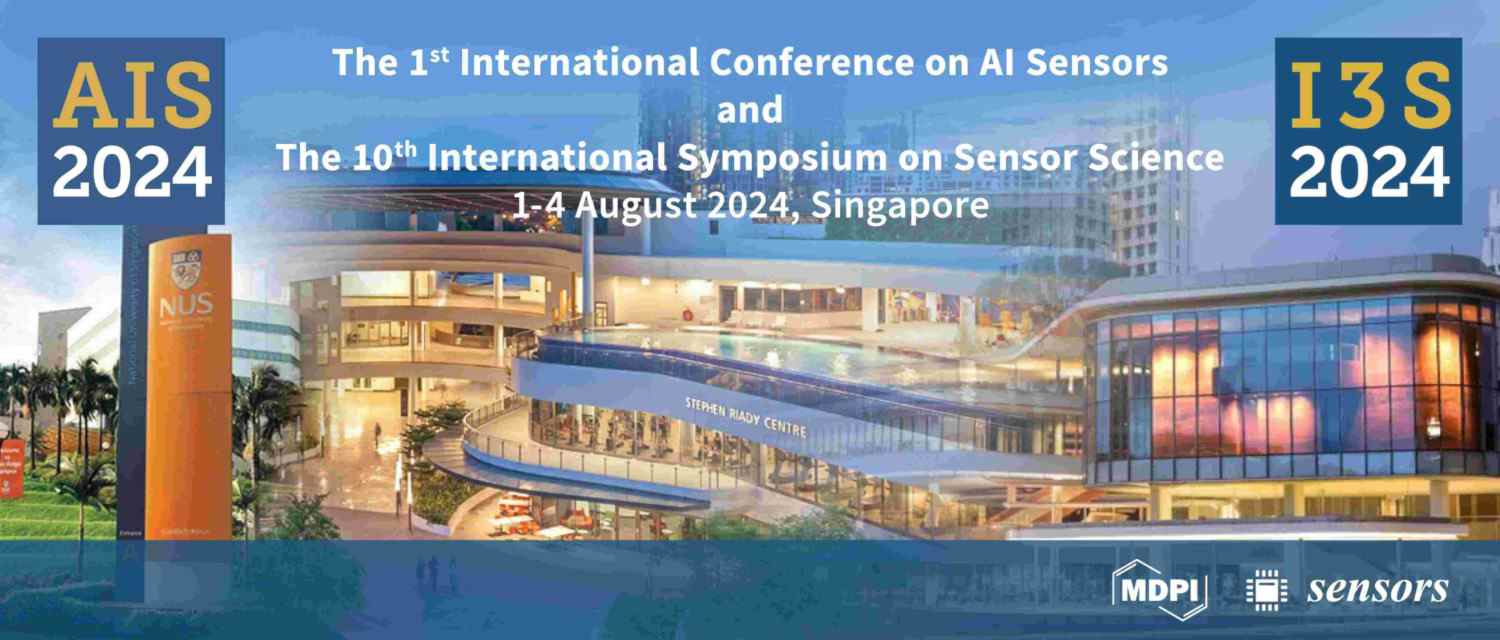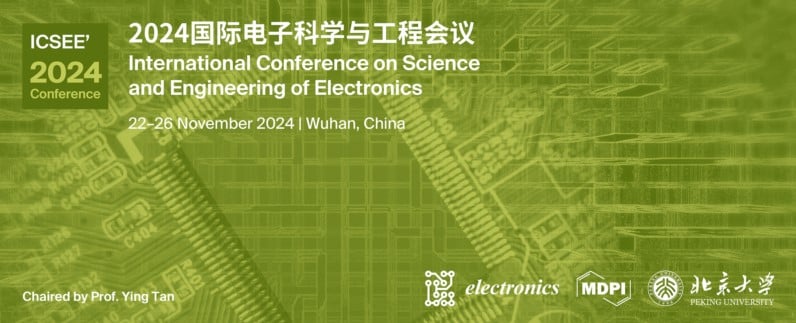Journal Description
Sensors
Sensors
is an international, peer-reviewed, open access journal on the science and technology of sensors. Sensors is published semimonthly online by MDPI. The Polish Society of Applied Electromagnetics (PTZE), Japan Society of Photogrammetry and Remote Sensing (JSPRS), Spanish Society of Biomedical Engineering (SEIB) and International Society for the Measurement of Physical Behaviour (ISMPB) are affiliated with Sensors and their members receive a discount on the article processing charges.
- Open Access — free for readers, with article processing charges (APC) paid by authors or their institutions.
- High Visibility: indexed within Scopus, SCIE (Web of Science), PubMed, MEDLINE, PMC, Ei Compendex, Inspec, Astrophysics Data System, and other databases.
- Journal Rank: JCR - Q2 (Instruments & Instrumentation) / CiteScore - Q1 (Instrumentation)
- Rapid Publication: manuscripts are peer-reviewed and a first decision is provided to authors approximately 17 days after submission; acceptance to publication is undertaken in 2.8 days (median values for papers published in this journal in the second half of 2023).
- Recognition of Reviewers: reviewers who provide timely, thorough peer-review reports receive vouchers entitling them to a discount on the APC of their next publication in any MDPI journal, in appreciation of the work done.
- Testimonials: See what our editors and authors say about Sensors.
- Companion journals for Sensors include: Chips, Automation, JCP and Targets.
Impact Factor:
3.9 (2022);
5-Year Impact Factor:
4.1 (2022)
Latest Articles
Automated Vibroacoustic Monitoring of Trees for Borer Infestation
Sensors 2024, 24(10), 3074; https://doi.org/10.3390/s24103074 (registering DOI) - 12 May 2024
Abstract
In previous research, we presented an apparatus designed for comprehensive and systematic surveillance of trees against borers. This apparatus entailed the insertion of an uncoated waveguide into the tree trunk, enabling the transmission of micro-vibrations generated by moving or digging larvae to a
[...] Read more.
In previous research, we presented an apparatus designed for comprehensive and systematic surveillance of trees against borers. This apparatus entailed the insertion of an uncoated waveguide into the tree trunk, enabling the transmission of micro-vibrations generated by moving or digging larvae to a piezoelectric probe. Subsequent recordings were then transmitted at predetermined intervals to a server, where analysis was conducted manually to assess the infestation status of the tree. However, this method is hampered by significant limitations when scaling to monitor thousands of trees across extensive spatial domains. In this study, we address this challenge by integrating signal processing techniques capable of distinguishing vibrations attributable to borers from those originating externally to the tree. Our primary innovation involves quantifying the impulses resulting from the fracturing of wood fibers due to borer activity. The device employs criteria such as impulse duration and a strategy of waiting for periods of relative quietness before commencing the counting of impulses. Additionally, we provide an annotated large-scale database comprising laboratory and field vibrational recordings, which will facilitate further advancements in this research domain.
Full article
(This article belongs to the Special Issue AI, IoT and Smart Sensors for Precision Agriculture)
►
Show Figures
Open AccessArticle
Engineering the Signal Resolution of a Paper-Based Cell-Free Glutamine Biosensor with Genetic Engineering, Metabolic Engineering, and Process Optimization
by
Tyler J. Free, Joseph P. Talley, Chad D. Hyer, Catherine J. Miller, Joel S. Griffitts and Bradley C. Bundy
Sensors 2024, 24(10), 3073; https://doi.org/10.3390/s24103073 (registering DOI) - 12 May 2024
Abstract
Specialized cancer treatments have the potential to exploit glutamine dependence to increase patient survival rates. Glutamine diagnostics capable of tracking a patient’s response to treatment would enable a personalized treatment dosage to optimize the tradeoff between treatment success and dangerous side effects. Current
[...] Read more.
Specialized cancer treatments have the potential to exploit glutamine dependence to increase patient survival rates. Glutamine diagnostics capable of tracking a patient’s response to treatment would enable a personalized treatment dosage to optimize the tradeoff between treatment success and dangerous side effects. Current clinical glutamine testing requires sophisticated and expensive lab-based tests, which are not broadly available on a frequent, individualized basis. To address the need for a low-cost, portable glutamine diagnostic, this work engineers a cell-free glutamine biosensor to overcome assay background and signal-to-noise limitations evident in previously reported studies. The findings from this work culminate in the development of a shelf-stable, paper-based, colorimetric glutamine test with a high signal strength and a high signal-to-background ratio for dramatically improved signal resolution. While the engineered glutamine test is important progress towards improving the management of cancer and other health conditions, this work also expands the assay development field of the promising cell-free biosensing platform, which can facilitate the low-cost detection of a broad variety of target molecules with high clinical value.
Full article
(This article belongs to the Special Issue Recent Innovations in Electrochemical Biosensors)
►▼
Show Figures

Figure 1
Open AccessArticle
Extended-Aperture Shape Measurements Using Spatially Partially Coherent Illumination (ExASPICE)
by
Mostafa Agour, Claas Falldorf and Ralf B. Bergmann
Sensors 2024, 24(10), 3072; https://doi.org/10.3390/s24103072 (registering DOI) - 12 May 2024
Abstract
We have recently demonstrated that the 3D shape of micro-parts can be measured using LED illumination based on speckle contrast evaluation in the recently developed SPICE profilometry (shape measurements based on imaging with spatially partially coherent illumination). The main advantage of SPICE is
[...] Read more.
We have recently demonstrated that the 3D shape of micro-parts can be measured using LED illumination based on speckle contrast evaluation in the recently developed SPICE profilometry (shape measurements based on imaging with spatially partially coherent illumination). The main advantage of SPICE is its improved robustness and measurement speed compared to confocal or white light interferometry. The limited spatial coherence of the LED illumination is used for depth discrimination. An electrically tunable lens in a
(This article belongs to the Section Sensing and Imaging)
►▼
Show Figures

Figure 1
Open AccessArticle
Full-Scale Modeling and FBGs Experimental Measurements for Thermal Analysis of Converter Transformer
by
Fan Yang, Sance Gao, Gepeng Wang, Hanxue Hao and Pengbo Wang
Sensors 2024, 24(10), 3071; https://doi.org/10.3390/s24103071 (registering DOI) - 12 May 2024
Abstract
As the imbalance between power demand and load capacity in electrical systems becomes increasingly severe, investigating the temperature variations in transformers under different load stresses is crucial for ensuring their safe operation. The thermal analysis of converter transformers poses challenges due to the
[...] Read more.
As the imbalance between power demand and load capacity in electrical systems becomes increasingly severe, investigating the temperature variations in transformers under different load stresses is crucial for ensuring their safe operation. The thermal analysis of converter transformers poses challenges due to the complexity of model construction. This paper develops a full-scale model of a converter transformer using a multi-core high-performance computer and explores its thermal state at 80%, 100%, and 120% loading ratios using the COUPLED iteration method. Additionally, to validate the simulation model, 24 FBGs are installed in the experimental transformer to record the temperature data. The results indicate a general upward trend in winding the temperature from bottom to top. However, an internal temperature rise followed by a decrease is observed within certain sections. Moreover, as the loading ratio increases, both the peak temperature and temperature differential of the transformer windings rise, reaching a peak temperature of 107.9 °C at a 120% loading ratio. The maximum discrepancy between the simulation and experimental results does not exceed 3.5%, providing effective guidance for the transformer design and operational maintenance.
Full article
(This article belongs to the Special Issue Fiber Grating Sensors and Applications)
►▼
Show Figures

Figure 1
Open AccessArticle
A Novel Lightweight Model for Underwater Image Enhancement
by
Botao Liu, Yimin Yang, Ming Zhao and Min Hu
Sensors 2024, 24(10), 3070; https://doi.org/10.3390/s24103070 (registering DOI) - 11 May 2024
Abstract
Underwater images suffer from low contrast and color distortion. In order to improve the quality of underwater images and reduce storage and computational resources, this paper proposes a lightweight model Rep-UWnet to enhance underwater images. The model consists of a fully connected convolutional
[...] Read more.
Underwater images suffer from low contrast and color distortion. In order to improve the quality of underwater images and reduce storage and computational resources, this paper proposes a lightweight model Rep-UWnet to enhance underwater images. The model consists of a fully connected convolutional network and three densely connected RepConv blocks in series, with the input images connected to the output of each block with a Skip connection. First, the original underwater image is subjected to feature extraction by the SimSPPF module and is processed through feature summation with the original one to be produced as the input image. Then, the first convolutional layer with a kernel size of 3 × 3, generates 64 feature maps, and the multi-scale hybrid convolutional attention module enhances the useful features by reweighting the features of different channels. Second, three RepConv blocks are connected to reduce the number of parameters in extracting features and increase the test speed. Finally, a convolutional layer with 3 kernels generates enhanced underwater images. Our method reduces the number of parameters from 2.7 M to 0.45 M (around 83% reduction) but outperforms state-of-the-art algorithms by extensive experiments. Furthermore, we demonstrate our Rep-UWnet effectively improves high-level vision tasks like edge detection and single image depth estimation. This method not only surpasses the contrast method in objective quality, but also significantly improves the contrast, colorimetry, and clarity of underwater images in subjective quality.
Full article
(This article belongs to the Collection Advances in Deep-Learning-Based Sensing, Imaging, and Video Processing)
Open AccessArticle
Self-Calibration Method for Circular Encoders Based on Inertia and a Single Read-Head
by
Xiaoyi Wang, Longyuan Xiao, Kunlei Zheng, Chengxiang Zhao, Mingkang Liu, Tianyang Yao, Dongjie Zhu, Gaojie Liang and Zhaoyao Shi
Sensors 2024, 24(10), 3069; https://doi.org/10.3390/s24103069 (registering DOI) - 11 May 2024
Abstract
This article proposes a new self-calibration method for circular encoders based on inertia and a single read-head. The velocity curves of the circular encoder are fitted with polynomials and, based on the principle of circle closure and the periodicity of the distribution for
[...] Read more.
This article proposes a new self-calibration method for circular encoders based on inertia and a single read-head. The velocity curves of the circular encoder are fitted with polynomials and, based on the principle of circle closure and the periodicity of the distribution for angle intervals, the proportionality between the theoretical value and the actual value of each angle interval is obtained. In the experimental system constructed, the feasibility of the proposed method was verified through self-calibration experiments, repeatability experiments, and comparative experiments with the time-measurement dynamic reversal (TDR) method. In addition, this article also proposes an iterative method to improve the self-calibration accuracy. Experimental verification was carried out, and the results show that the new method can effectively compensate for the error of angle measurement in the circular encoder. The peak-to-peak value of the error of angle measurement was reduced from 239.343” to 11.867”, and the repeatability of the calibration results of the new method was less than 2.77”.
Full article
(This article belongs to the Section Optical Sensors)
Open AccessArticle
Electrical Sensor Calibration by Fuzzy Clustering with Mandatory Constraint
by
Shihong Yue, Keyi Fu, Liping Liu and Yuwei Zhao
Sensors 2024, 24(10), 3068; https://doi.org/10.3390/s24103068 (registering DOI) - 11 May 2024
Abstract
Electrical tomography sensors have been widely used for pipeline parameter detection and estimation. Before they can be used in formal applications, the sensors must be calibrated using enough labeled data. However, due to the high complexity of actual measuring environments, the calibrated sensors
[...] Read more.
Electrical tomography sensors have been widely used for pipeline parameter detection and estimation. Before they can be used in formal applications, the sensors must be calibrated using enough labeled data. However, due to the high complexity of actual measuring environments, the calibrated sensors are inaccurate since the labeling data may be uncertain, inconsistent, incomplete, or even invalid. Alternatively, it is always possible to obtain partial data with accurate labels, which can form mandatory constraints to correct errors in other labeling data. In this paper, a semi-supervised fuzzy clustering algorithm is proposed, and the fuzzy membership degree in the algorithm leads to a set of mandatory constraints to correct these inaccurate labels. Experiments in a dredger validate the proposed algorithm in terms of its accuracy and stability. This new fuzzy clustering algorithm can generally decrease the error of labeling data in any sensor calibration process.
Full article
(This article belongs to the Section Electronic Sensors)
Open AccessArticle
High-Voltage Cable Buffer Layer Ablation Fault Identification Based on Artificial Intelligence and Frequency Domain Impedance Spectroscopy
by
Jiajun Liu, Mingchao Ma, Xin Liu and Haokun Xu
Sensors 2024, 24(10), 3067; https://doi.org/10.3390/s24103067 (registering DOI) - 11 May 2024
Abstract
In recent years, the occurrence of high-voltage cable buffer layer ablation faults has become frequent, posing a serious threat to the safe and stable operation of cables. Failure to promptly detect and address such faults may lead to cable breakdowns, impacting the normal
[...] Read more.
In recent years, the occurrence of high-voltage cable buffer layer ablation faults has become frequent, posing a serious threat to the safe and stable operation of cables. Failure to promptly detect and address such faults may lead to cable breakdowns, impacting the normal operation of the power system. To overcome the limitations of existing methods for identifying buffer layer ablation faults in high-voltage cables, a method for identifying buffer layer ablation faults based on frequency domain impedance spectroscopy and artificial intelligence is proposed. Firstly, based on the cable distributed parameter model and frequency domain impedance spectroscopy, a mathematical model of the input impedance of a cable containing buffer layer ablation faults is derived. Through a simulation, the input impedance spectroscopy at the first end of the cables under normal conditions, buffer layer ablation, local aging, and inductive faults is performed, enabling the identification of inductive and capacitive faults through a comparative analysis. Secondly, the frequency domain amplitude spectroscopy of the buffer layer ablation and local aging faults are used as datasets and are input into a neural network model for training and validation to identify buffer layer ablation and local aging faults. Finally, using multiple evaluation metrics to assess the neural network model validates the superiority of the MLP neural network in cable fault identification models and experimentally confirms the effectiveness of the proposed method.
Full article
(This article belongs to the Section Fault Diagnosis & Sensors)
►▼
Show Figures

Figure 1
Open AccessArticle
Automatic Localization of Soybean Seedlings Based on Crop Signaling and Multi-View Imaging
by
Bo Jiang, He-Yi Zhang and Wen-Hao Su
Sensors 2024, 24(10), 3066; https://doi.org/10.3390/s24103066 (registering DOI) - 11 May 2024
Abstract
Soybean is grown worldwide for its high protein and oil content. Weeds compete fiercely for resources, which affects soybean yields. Because of the progressive enhancement of weed resistance to herbicides and the quickly increasing cost of manual weeding, mechanical weed control is becoming
[...] Read more.
Soybean is grown worldwide for its high protein and oil content. Weeds compete fiercely for resources, which affects soybean yields. Because of the progressive enhancement of weed resistance to herbicides and the quickly increasing cost of manual weeding, mechanical weed control is becoming the preferred method of weed control. Mechanical weed control finds it difficult to remove intra-row weeds due to the lack of rapid and precise weed/soybean detection and location technology. Rhodamine B (Rh-B) is a systemic crop compound that can be absorbed by soybeans which fluoresces under a specific excitation light. The purpose of this study is to combine systemic crop compounds and computer vision technology for the identification and localization of soybeans in the field. The fluorescence distribution properties of systemic crop compounds in soybeans and their effects on plant growth were explored. The fluorescence was mainly concentrated in soybean cotyledons treated with Rh-B. After a comparison of soybean seedlings treated with nine groups of rhodamine B solutions at different concentrations ranging from 0 to 1440 ppm, the soybeans treated with 180 ppm Rh-B for 24 h received the recommended dosage, resulting in significant fluorescence that did not affect crop growth. Increasing the Rh-B concentration reduced crop biomass, while prolonged treatment times reduced seed germination. The fluorescence produced lasted for 20 days, ensuring a stable signal in the early stages of growth. Additionally, a precise inter-row soybean plant location system based on a fluorescence imaging system with a 96.7% identification accuracy, determined on 300 datasets, was proposed. This article further confirms the potential of crop signaling technology to assist machines in achieving crop identification and localization in the field.
Full article
(This article belongs to the Section Smart Agriculture)
Open AccessArticle
Temperature-Switch-Controlled Second Harmonic Mode Sensor for Brain-Tissue Detection
by
Xiang Li, Cheng Yang, Chuming Guo, Qijuan Li, Chuan Peng and Haifeng Zhang
Sensors 2024, 24(10), 3065; https://doi.org/10.3390/s24103065 (registering DOI) - 11 May 2024
Abstract
Identifying brain-tissue types holds significant research value in the biomedical field of non-contact brain-tissue measurement applications. In this paper, a layered metastructure is proposed, and the second harmonic generation (SHG) in a multilayer metastructure is derived using the transfer matrix method. With the
[...] Read more.
Identifying brain-tissue types holds significant research value in the biomedical field of non-contact brain-tissue measurement applications. In this paper, a layered metastructure is proposed, and the second harmonic generation (SHG) in a multilayer metastructure is derived using the transfer matrix method. With the SHG conversion efficiency (CE) as the measurement signal, the refractive index ranges that can be distinguished are 1.23~1.31 refractive index unit (RIU) and 1.38~1.44 RIU, with sensitivities of 0.8597 RIU−1 and 1.2967 RIU−1, respectively. It can distinguish various brain tissues, including gray matter, white matter, and low-grade glioma, achieving the function of a second harmonic mode sensor (SHMS). Furthermore, temperature has a significant impact on the SHG CE, which can be used to define the switch signal indicating whether the SHMS is functioning properly. When the temperature range is 291.4~307.9 Kelvin (K), the temperature switch is in the “open” state, and the optimal SHG CE is higher than 0.298%, indicating that the SHMS is in the working state. For other temperature ranges, the SHG CE will decrease significantly, indicating that the temperature switch is in the “off” state, and the SHMS is not working. By stimulating temperature and using the response of SHG CE, the temperature-switch function is achieved, providing a new approach for temperature-controlled second harmonic detection.
Full article
(This article belongs to the Section Physical Sensors)
►▼
Show Figures

Figure 1
Open AccessReview
Comprehensive Investigation of Unmanned Aerial Vehicles (UAVs): An In-Depth Analysis of Avionics Systems
by
Khaled Osmani and Detlef Schulz
Sensors 2024, 24(10), 3064; https://doi.org/10.3390/s24103064 (registering DOI) - 11 May 2024
Abstract
The evolving technologies regarding Unmanned Aerial Vehicles (UAVs) have led to their extended applicability in diverse domains, including surveillance, commerce, military, and smart electric grid monitoring. Modern UAV avionics enable precise aircraft operations through autonomous navigation, obstacle identification, and collision prevention. The structures
[...] Read more.
The evolving technologies regarding Unmanned Aerial Vehicles (UAVs) have led to their extended applicability in diverse domains, including surveillance, commerce, military, and smart electric grid monitoring. Modern UAV avionics enable precise aircraft operations through autonomous navigation, obstacle identification, and collision prevention. The structures of avionics are generally complex, and thorough hierarchies and intricate connections exist in between. For a comprehensive understanding of a UAV design, this paper aims to assess and critically review the purpose-classified electronics hardware inside UAVs, each with the corresponding performance metrics thoroughly analyzed. This review includes an exploration of different algorithms used for data processing, flight control, surveillance, navigation, protection, and communication. Consequently, this paper enriches the knowledge base of UAVs, offering an informative background on various UAV design processes, particularly those related to electric smart grid applications. As a future work recommendation, an actual relevant project is openly discussed.
Full article
(This article belongs to the Section Intelligent Sensors)
►▼
Show Figures

Figure 1
Open AccessArticle
DSOMF: A Dynamic Environment Simultaneous Localization and Mapping Technique Based on Machine Learning
by
Shengzhe Yue, Zhengjie Wang and Xiaoning Zhang
Sensors 2024, 24(10), 3063; https://doi.org/10.3390/s24103063 (registering DOI) - 11 May 2024
Abstract
To address the challenges of reduced localization accuracy and incomplete map construction demonstrated using classical semantic simultaneous localization and mapping (SLAM) algorithms in dynamic environments, this study introduces a dynamic scene SLAM technique that builds upon direct sparse odometry (DSO) and incorporates instance
[...] Read more.
To address the challenges of reduced localization accuracy and incomplete map construction demonstrated using classical semantic simultaneous localization and mapping (SLAM) algorithms in dynamic environments, this study introduces a dynamic scene SLAM technique that builds upon direct sparse odometry (DSO) and incorporates instance segmentation and video completion algorithms. While prioritizing the algorithm’s real-time performance, we leverage the rapid matching capabilities of Direct Sparse Odometry (DSO) to link identical dynamic objects in consecutive frames. This association is achieved through merging semantic and geometric data, thereby enhancing the matching accuracy during image tracking through the inclusion of semantic probability. Furthermore, we incorporate a loop closure module based on video inpainting algorithms into our mapping thread. This allows our algorithm to rely on the completed static background for loop closure detection, further enhancing the localization accuracy of our algorithm. The efficacy of this approach is validated using the TUM and KITTI public datasets and the unmanned platform experiment. Experimental results show that, in various dynamic scenes, our method achieves an improvement exceeding 85% in terms of localization accuracy compared with the DSO system.
Full article
(This article belongs to the Topic 3D Computer Vision and Smart Building and City, 2nd Volume)
Open AccessArticle
Hadamard Error-Correcting Codes and Their Application in Digital Watermarking
by
Michael Windisch, Jakob Wassermann, Monica Leba and Olimpiu Stoicuta
Sensors 2024, 24(10), 3062; https://doi.org/10.3390/s24103062 (registering DOI) - 11 May 2024
Abstract
In communication technologies such as digital watermarking, wireless sensor networks (WSNs), and visual light communication (VLC), error-correcting codes are crucial. The Enhanced Hadamard Error-Correcting Code (EHC), which is based on 2D Hadamard Basis Images, is a novel error correction technique that is presented
[...] Read more.
In communication technologies such as digital watermarking, wireless sensor networks (WSNs), and visual light communication (VLC), error-correcting codes are crucial. The Enhanced Hadamard Error-Correcting Code (EHC), which is based on 2D Hadamard Basis Images, is a novel error correction technique that is presented in this study. This technique is used to evaluate the effectiveness of the video watermarking scheme. Even with highly sophisticated embedding techniques, watermarks usually fail to resist such comprehensive attacks because of the extraordinarily high compression rate of approximately 1:200 that is frequently employed in video dissemination. It can only be used in conjunction with a sufficient error-correcting coding method. This study compares the efficacy of the well-known Reed–Solomon Code with this novel technique, the Enhanced Hadamard Error-Correcting Code (EHC), in maintaining watermarks in embedded videos. The main idea behind this newly created multidimensional Enhanced Hadamard Error-Correcting Code is to use a 1D Hadamard decoding approach on the 2D base pictures after they have been transformed into a collection of one-dimensional rows. Following that, the image is rebuilt, allowing for a more effective 2D decoding procedure. Using this technique, it is possible to exceed the theoretical error-correcting capacity threshold of ⌊
(This article belongs to the Section Communications)
►▼
Show Figures

Figure 1
Open AccessArticle
Seismic Monitoring of a Deep Geothermal Field in Munich (Germany) Using Borehole Distributed Acoustic Sensing
by
Jérôme Azzola and Emmanuel Gaucher
Sensors 2024, 24(10), 3061; https://doi.org/10.3390/s24103061 (registering DOI) - 11 May 2024
Abstract
Geothermal energy exploitation in urban areas necessitates robust real-time seismic monitoring for risk mitigation. While surface-based seismic networks are valuable, they are sensitive to anthropogenic noise. This study investigates the capabilities of borehole Distributed Acoustic Sensing (DAS) for local seismic monitoring of a
[...] Read more.
Geothermal energy exploitation in urban areas necessitates robust real-time seismic monitoring for risk mitigation. While surface-based seismic networks are valuable, they are sensitive to anthropogenic noise. This study investigates the capabilities of borehole Distributed Acoustic Sensing (DAS) for local seismic monitoring of a geothermal field located in Munich, Germany. We leverage the operator’s cloud infrastructure for DAS data management and processing. We introduce a comprehensive workflow for the automated processing of DAS data, including seismic event detection, onset time picking, and event characterization. The latter includes the determination of the event hypocenter, origin time, seismic moment, and stress drop. Waveform-based parameters are obtained after the automatic conversion of the DAS strain-rate to acceleration. We present the results of a 6-month monitoring period that demonstrates the capabilities of the proposed monitoring set-up, from the management of DAS data volumes to the establishment of an event catalog. The comparison of the results with seismometer data shows that the phase and amplitude of DAS data can be reliably used for seismic processing. This emphasizes the potential of improving seismic monitoring capabilities with hybrid networks, combining surface and downhole seismometers with borehole DAS. The inherent high-density array configuration of borehole DAS proves particularly advantageous in urban and operational environments. This study stresses that realistic prior knowledge of the seismic velocity model remains essential to prevent a large number of DAS sensing points from biasing results and interpretation. This study suggests the potential for a gradual extension of the network as geothermal exploitation progresses and new wells are equipped, owing to the scalability of the described monitoring system.
Full article
(This article belongs to the Special Issue Sensor Technologies for Seismic Monitoring)
►▼
Show Figures

Figure 1
Open AccessArticle
The Validity and Reliability of a Real-Time Biofeedback System for Lumbopelvic Control Training in Baseball Players
by
Shiu-Min Wang, Po-Hsien Jiang, Kuei-Yuan Chan and Wei-Li Hsu
Sensors 2024, 24(10), 3060; https://doi.org/10.3390/s24103060 (registering DOI) - 11 May 2024
Abstract
Background: This study validates real-time biofeedback for lumbopelvic control training in baseball. The lumbopelvic region is crucial for generating kinetic energy in pitching. Real-time biofeedback enhances training effectiveness and reduces injury risk. The validity and reliability of this system were examined. Purpose: This
[...] Read more.
Background: This study validates real-time biofeedback for lumbopelvic control training in baseball. The lumbopelvic region is crucial for generating kinetic energy in pitching. Real-time biofeedback enhances training effectiveness and reduces injury risk. The validity and reliability of this system were examined. Purpose: This study was to investigate the validity and reliability of the real-time biofeedback system for lumbopelvic control training. Methods: Twelve baseball players participated in this study, with data collected in two sessions separated by a week. All participants needed to do the lateral slide exercise and single-leg squat exercise in each session. Pelvic angles detected by the real-time biofeedback system were compared to the three-dimensional motion capture system (VICON) during training sessions. Additionally, pelvic angles measured by the biofeedback system were compared between the two training sessions. Results: The real-time biofeedback system exhibited moderate to strong correlations with VICON in both exercises: lateral slide exercise (r = 0.66–0.88, p < 0.05) and single-leg squat exercise (r = 0.70–0.85, p < 0.05). Good to excellent reliability was observed between the first and second sessions for both exercises: lateral slide exercise (ICC = 0.76–0.97) and single-leg squat exercise (ICC = 0.79–0.90). Conclusions: The real-time biofeedback system for lumbopelvic control training, accurately providing the correct pelvic angle during training, could enhance training effectiveness.
Full article
(This article belongs to the Special Issue Intelligent Wearable Sensor-Based Gait and Movement Analysis)
►▼
Show Figures

Figure 1
Open AccessArticle
A Novel Low-Frequency Electromagnetic Active Inertial Sensor for Drug Detection
by
Erietta Vasilaki, Emmanouil Markoulakis, Diamanto Lazari, Antonia Psaroudaki, Ioannis Barbounakis and Emmanuel Antonidakis
Sensors 2024, 24(10), 3059; https://doi.org/10.3390/s24103059 (registering DOI) - 11 May 2024
Abstract
The purpose of this paper is to demonstrate a new discovery regarding the interaction between materials and very low radio frequencies. Specifically, we observed a feedback response on an inertia active sensor when specific frequencies (around 2–4 kHz) are used to irradiate targeted
[...] Read more.
The purpose of this paper is to demonstrate a new discovery regarding the interaction between materials and very low radio frequencies. Specifically, we observed a feedback response on an inertia active sensor when specific frequencies (around 2–4 kHz) are used to irradiate targeted pharmaceutical samples like aspirin or paracetamol drugs. The characteristics of this phenomenon, such as excitation and relaxation time, the relation between deceleration and a material’s quantity, and signal amplitude, are presented and analyzed. Although the underlying physics of this phenomenon is not yet known, we have shown that it has potential applications in remote identification of compounds, detection, and location sensing, as well as identifying substances that exist in plants without the need for any processing. This method is fast, accurate, low-cost, non-destructive, and non-invasive, making it a valuable area for further research that could yield spectacular results in the future.
Full article
(This article belongs to the Section Biosensors)
►▼
Show Figures

Figure 1
Open AccessArticle
Enhancing the Responsiveness of Thermoelectric Gas Sensors with Boron-Doped and Thermally Annealed SiGe Thin Films via Low-Pressure Chemical Vapor Deposition
by
Woosuck Shin, Maiko Nishibori, Toshio Itoh, Noriya Izu and Ichiro Matsubara
Sensors 2024, 24(10), 3058; https://doi.org/10.3390/s24103058 (registering DOI) - 11 May 2024
Abstract
Thermoelectric gas sensor (THGS) devices with catalysts and Si0.8Ge0.2 thin films of different boron doping levels of 1018, 1019, and 1020 cm−3 were fabricated, and their transport properties are investigated. SiGe films were deposited
[...] Read more.
Thermoelectric gas sensor (THGS) devices with catalysts and Si0.8Ge0.2 thin films of different boron doping levels of 1018, 1019, and 1020 cm−3 were fabricated, and their transport properties are investigated. SiGe films were deposited on Si3N4/SiO2 multilayers on Si substrates using low-pressure chemical vapor deposition (LPCVD) and thermally annealed at 1050 °C. The Seebeck coefficients of the SiGe films were increased after thermal annealing, ranging from 191 to 275 μV/K at temperatures of 74 to 468 °C in air, and reaching the highest power factor of 6.78 × 10−4 W/mK2 at 468 °C. The thermal conductivity of the SiGe films varied from 2.4 to 3.0 W/mK at 25 °C. The THGS detection performance was tested for the H2 gas in air from 0.01 to 1.0%, and compared to the thermoelectric properties of the SiGe films. The high-temperature annealing treatment process was successful in enhancing the thermoelectric performance of both the SiGe films and sensor devices, achieving the best THGS performance with the sensor device fabricated from the annealed SiGe film with 1018 cm−3 boron-doped Si0.8Ge0.2.
Full article
(This article belongs to the Section Chemical Sensors)
►▼
Show Figures

Figure 1
Open AccessArticle
Novel Approach Combining Shallow Learning and Ensemble Learning for the Automated Detection of Swallowing Sounds in a Clinical Database
by
Satoru Kimura, Takahiro Emoto, Yoshitaka Suzuki, Mizuki Shinkai, Akari Shibagaki and Fumio Shichijo
Sensors 2024, 24(10), 3057; https://doi.org/10.3390/s24103057 (registering DOI) - 11 May 2024
Abstract
Cervical auscultation is a simple, noninvasive method for diagnosing dysphagia, although the reliability of the method largely depends on the subjectivity and experience of the evaluator. Recently developed methods for the automatic detection of swallowing sounds facilitate a rough automatic diagnosis of dysphagia,
[...] Read more.
Cervical auscultation is a simple, noninvasive method for diagnosing dysphagia, although the reliability of the method largely depends on the subjectivity and experience of the evaluator. Recently developed methods for the automatic detection of swallowing sounds facilitate a rough automatic diagnosis of dysphagia, although a reliable method of detection specialized in the peculiar feature patterns of swallowing sounds in actual clinical conditions has not been established. We investigated a novel approach for automatically detecting swallowing sounds by a method wherein basic statistics and dynamic features were extracted based on acoustic features: Mel Frequency Cepstral Coefficients and Mel Frequency Magnitude Coefficients, and an ensemble learning model combining Support Vector Machine and Multi-Layer Perceptron were applied. The evaluation of the effectiveness of the proposed method, based on a swallowing-sounds database synchronized to a video fluorographic swallowing study compiled from 74 advanced-age patients with dysphagia, demonstrated an outstanding performance. It achieved an F1-micro average of approximately 0.92 and an accuracy of 95.20%. The method, proven effective in the current clinical recording database, suggests a significant advancement in the objectivity of cervical auscultation. However, validating its efficacy in other databases is crucial for confirming its broad applicability and potential impact.
Full article
(This article belongs to the Special Issue Artificial-Intelligence-Enhanced Wearable Sensing Technologies for Biomechanical and Physiological Monitoring and Analysis)
►▼
Show Figures

Figure 1
Open AccessArticle
A Circularly Polarized Non-Resonant Slotted Waveguide Antenna Array for Wide-Angle Scanning
by
Guodong Han and Weihang Liu
Sensors 2024, 24(10), 3056; https://doi.org/10.3390/s24103056 (registering DOI) - 11 May 2024
Abstract
A compact circularly polarized non-resonant slotted waveguide antenna array is proposed with the aim of achieving wide-angle scanning, circular polarization, and low side-lobe levels. The designed antenna demonstrates a scanning range of +11° to +13° in the frequency domain and a beam scanning
[...] Read more.
A compact circularly polarized non-resonant slotted waveguide antenna array is proposed with the aim of achieving wide-angle scanning, circular polarization, and low side-lobe levels. The designed antenna demonstrates a scanning range of +11° to +13° in the frequency domain and a beam scanning range of −45° to +45° in the phase domain. This design exhibits significant advantages for low-cost two-dimensional electronic scanning circularly polarized arrays. It employs a compact element that reduces the aperture area by 50% compared to traditional circular polarization cavities. Additionally, the staggered array method is employed to achieve an element spacing of 0.57
(This article belongs to the Special Issue Robust Parameter Estimation with Sensor Arrays in Complex Electromagnetic Environments)
►▼
Show Figures

Figure 1
Open AccessArticle
Dual-Message QR Codes
by
Kuo-Chien Chou and Ran-Zan Wang
Sensors 2024, 24(10), 3055; https://doi.org/10.3390/s24103055 (registering DOI) - 11 May 2024
Abstract
A novel dual-message QR code is proposed for carrying two individual messages that can be read by standard QR code readers: one from a close range and the other from a large distance. By exploring the module value determining the rule of typical
[...] Read more.
A novel dual-message QR code is proposed for carrying two individual messages that can be read by standard QR code readers: one from a close range and the other from a large distance. By exploring the module value determining the rule of typical QR code readers, we designed two-state module blocks that can be recognized as different module values through changing the distance from which the QR code is scanned, and applied them to construct the proposed dual-message QR code. Experiments were conducted to test the readability of the two messages within a dual-message QR code, with the results demonstrating the high feasibility of the proposed method. The dual-message QR code can be applied for designing creative applications. For example, an interactive wedding card that can access the growing film of the groom and that of the bride interchangeably, which bring the viewers a higher-quality experience.
Full article
(This article belongs to the Special Issue Data Engineering in the Internet of Things—Second Edition)

Journal Menu
► ▼ Journal Menu-
- Sensors Home
- Aims & Scope
- Editorial Board
- Reviewer Board
- Topical Advisory Panel
- Instructions for Authors
- Special Issues
- Topics
- Sections & Collections
- Article Processing Charge
- Indexing & Archiving
- Editor’s Choice Articles
- Most Cited & Viewed
- Journal Statistics
- Journal History
- Journal Awards
- Society Collaborations
- Conferences
- Editorial Office
Journal Browser
► ▼ Journal Browser-
arrow_forward_ios
Forthcoming issue
arrow_forward_ios Current issue - Vol. 24 (2024)
- Vol. 23 (2023)
- Vol. 22 (2022)
- Vol. 21 (2021)
- Vol. 20 (2020)
- Vol. 19 (2019)
- Vol. 18 (2018)
- Vol. 17 (2017)
- Vol. 16 (2016)
- Vol. 15 (2015)
- Vol. 14 (2014)
- Vol. 13 (2013)
- Vol. 12 (2012)
- Vol. 11 (2011)
- Vol. 10 (2010)
- Vol. 9 (2009)
- Vol. 8 (2008)
- Vol. 7 (2007)
- Vol. 6 (2006)
- Vol. 5 (2005)
- Vol. 4 (2004)
- Vol. 3 (2003)
- Vol. 2 (2002)
- Vol. 1 (2001)
Highly Accessed Articles
Latest Books
E-Mail Alert
News
Topics
Topic in
Materials, Nanomaterials, Photonics, Polymers, Applied Sciences, Sensors
Optical and Optoelectronic Properties of Materials and Their Applications
Topic Editors: Zhiping Luo, Gibin George, Navadeep ShrivastavaDeadline: 20 May 2024
Topic in
Remote Sensing, Sensors, Smart Cities, Vehicles, Geomatics
Information Sensing Technology for Intelligent/Driverless Vehicle, 2nd Volume
Topic Editors: Yan Huang, Yi Ren, Penghui Huang, Jun Wan, Zhanye Chen, Shiyang TangDeadline: 31 May 2024
Topic in
Applied Sciences, Electricity, Electronics, Energies, Sensors
Power System Protection
Topic Editors: Seyed Morteza Alizadeh, Akhtar KalamDeadline: 20 June 2024
Topic in
Applied Sciences, Energies, Machines, Sensors, Vehicles
Vehicle Dynamics and Control
Topic Editors: Peter Gaspar, Junnian WangDeadline: 30 June 2024

Conferences
Special Issues
Special Issue in
Sensors
Meta-User Interfaces for Ambient Environments
Guest Editors: Marco Romano, Phillip C-Y. Sheu, Giuliana VitielloDeadline: 20 May 2024
Special Issue in
Sensors
Selected Papers from 20th World Conference on Non-Destructive Testing (WCNDT 2022)
Guest Editor: Seunghee ParkDeadline: 31 May 2024
Special Issue in
Sensors
Novel Sensors and Algorithms for Outdoor Mobile Robot
Guest Editors: Levente Tamás, Andras MajdikDeadline: 20 June 2024
Special Issue in
Sensors
Deep Learning Methods for Human Activity Recognition and Emotion Detection
Guest Editor: Mario Munoz-OrganeroDeadline: 30 June 2024
Topical Collections
Topical Collection in
Sensors
Robotic and Sensor Technologies in Environmental Exploration and Monitoring
Collection Editors: Jacopo Aguzzi, Corrado Costa, Sergio Stefanni, Valerio Funari
Topical Collection in
Sensors
Microfluidic Sensors
Collection Editors: Sabina Merlo, Klaus Stefan Drese












